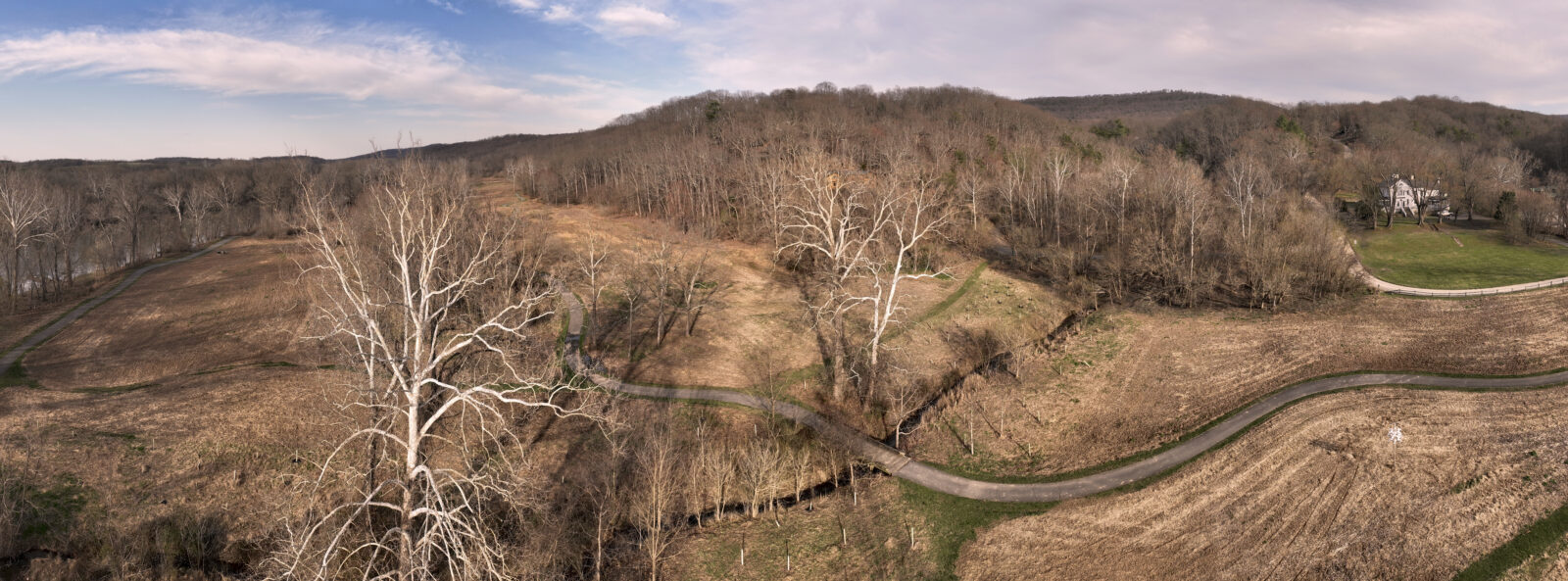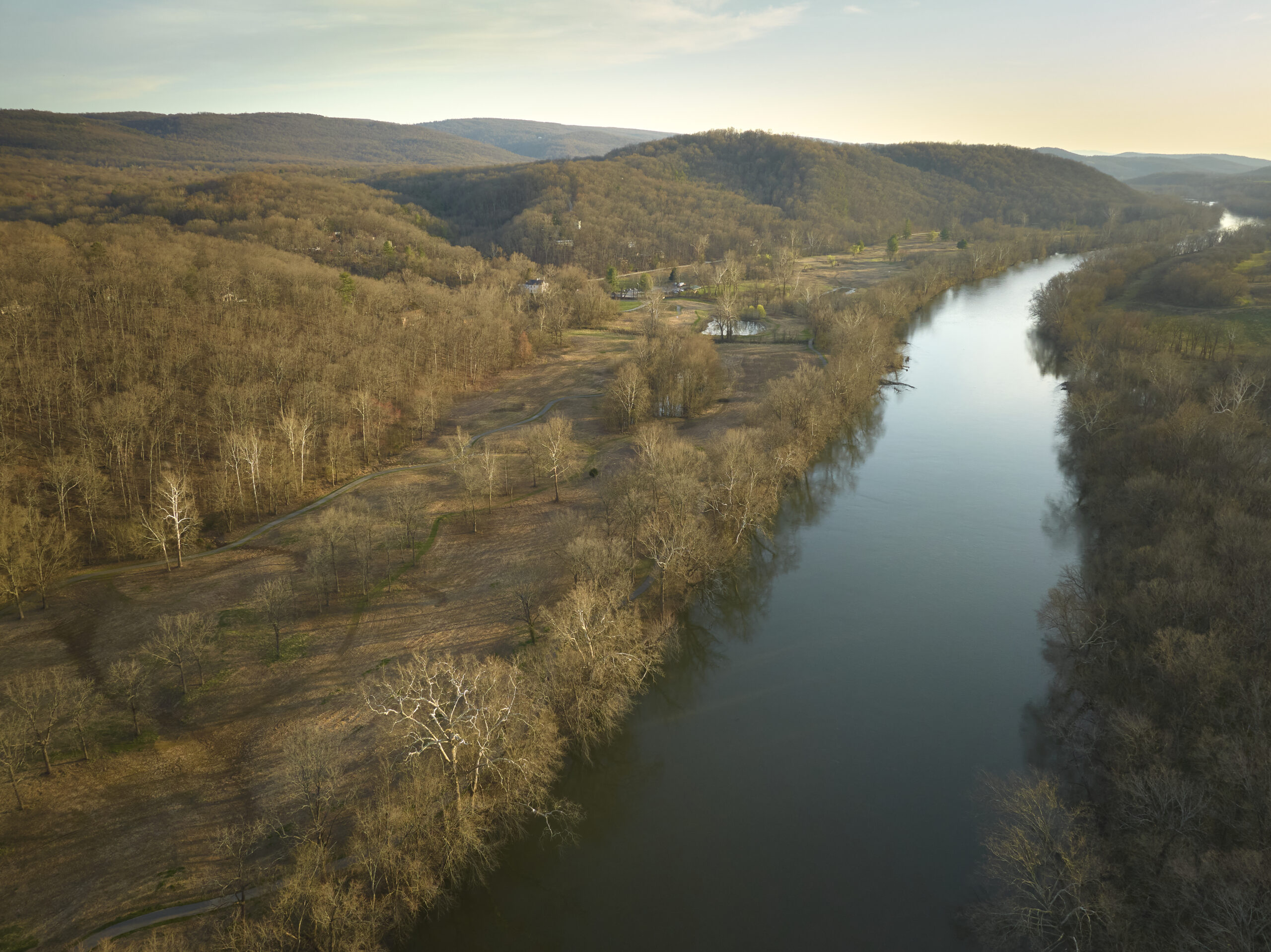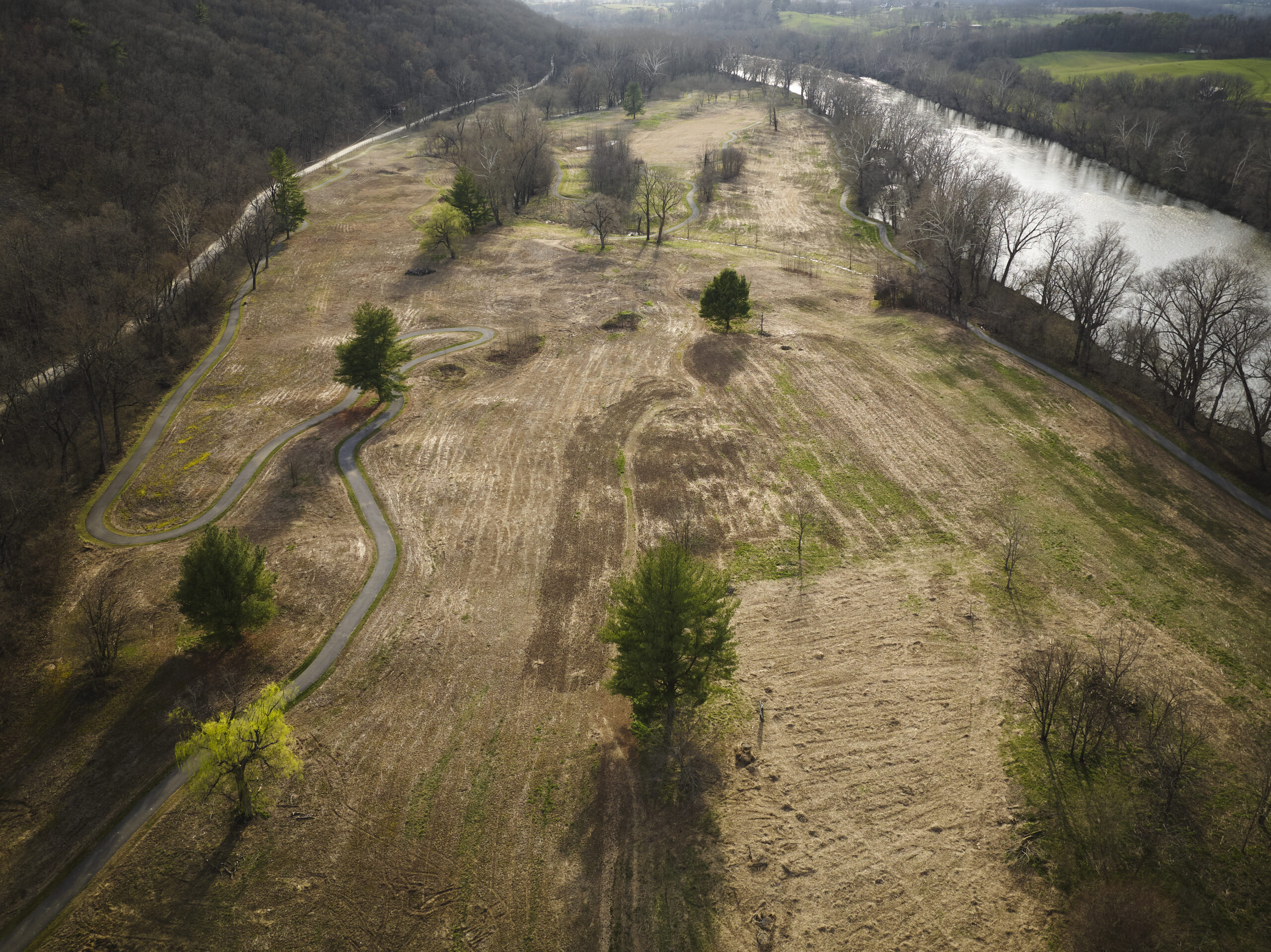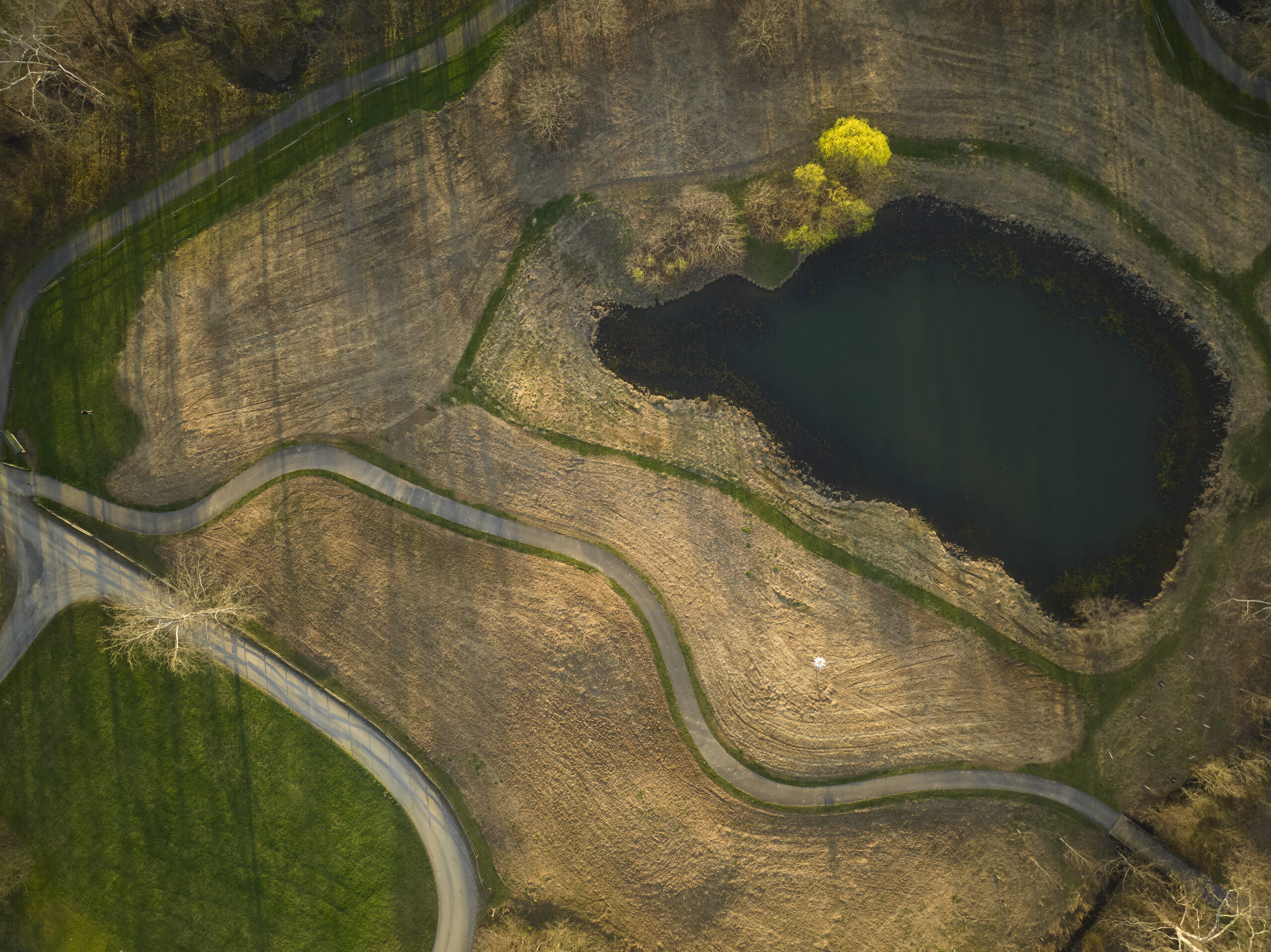When a Golf Course Goes Back to Nature

Written by Bill Kent | Photos by Shannon Ayres
For 10 years Gene Lewis has hiked, climbed, waded, swum, paddled a canoe, fished, and otherwise explored every inch of a former golf course on the Shenandoah River’s eastern bank.
As manager of Shenandoah University’s Cool Spring Campus, Lewis acts as lone caretaker, informal guide, host to university students, occasional gardener, and supervisor of contractors who are slowly letting what was once Clarke County’s Virginia National Golf Course go back to nature.
“Every day I see something new,” he says. The time just before trees grow heavy with spring blossoms just might be his favorite, “because of what I can see. You can look through the trees and appreciate what is normally hidden for most of the year.”
To his left, in the shadow of a ridge that climbs a few hundred feet to the east, are sand bunkers that have become ponds where turtles sun themselves. To the west, a wall of trees rises over the riverbank. “There’s a heronry along the very top. Look just to the right. That’s a bald eagle’s nest.”
Below the tree line, where the river widens as it flows north, “it’s a lot deeper than it looks. During the Civil War, soldiers tried to ford the river here. They were swept under and drowned.” Lewis points to a tangle of driftwood along the river’s bank. “The Underground Railroad came through here. Before the war, escaped slaves followed the river north seeking freedom. Some of them drowned, too.”
Though there hasn’t been a major flood in this part of the Shenandoah Valley for several years, among the debris floating on high water has been a full-sized recreational vehicle. “I don’t know how it got in there, or where it ended up.”
The golf cart trail eventually climbs past native grass meadows, new plantings of native trees, and a lone pine growing in what was once a fairway to the high ridge running over the floodplain. To the north, across a small creek, is the Rocky Branch waterfall. A few houses from the adjacent Shenandoah Retreat development are visible along the crown of the ridge. “I’ve got to know some of the people who live there. One person comes here so often that he donated a trail bench so he could sit down and admire the views.”

To the south, near a tee box fringed by scraggly grass and multiflora rose, a sign indicates the location of a Federal Army gun emplacement. Through the trees can be seen a farm on the grounds of the Holy Cross Abbey, where most of the 1864 Battle of Cool Spring was fought.
“Some of the monks come over here on long walks. They’re good neighbors. They say a long walk here is very peaceful. A lot of what’s going on here regarding the wildlife habitats is still a work in progress, especially with invasive species, but as for the peacefulness, I wholeheartedly agree.”
The National is not the only Northern Virginia golf course on a path to a more natural state. In 2019, the General’s Ridge in Manassas Park closed to become Blooms Park, a city-owned recreation area.
Just don’t call the 197-acre Shenandoah Cool Spring Campus a park. Located off Route 7 at the end of Parker Street, it is open dawn to dusk, and is featured on several websites as ideal for hiking, running, birdwatching, dog walking, picnicking, and battlefield exploration. Because it is private property and a state-protected battlefield, metal detecting, excavation, overnight camping, hunting, open fires, trail riding, and the consumption of alcohol are all forbidden.
“It’s more of a laboratory for the University that’s open to the public,” Lewis adds. “We think of it as a living classroom.”
University students, nationally known scholars, and the occasional busload of high school students on a field trip visit the campus several times a year to gain an overall appreciation of the site’s historical value, as well as its contemporary role in the greater Hunt Country environment. They are first taken to the golf course’s former log cabin clubhouse. No food or drinks are served, but visitors can view murals, examine maps, and view display cases of Civil War artifacts, including a remarkably well-preserved shoe from the 1864 battle for which the campus is named.
They are among hundreds that were found on the river’s western bank, excavated from the grounds of the Holy Cross Abbey monastery. According to history professor Jonathan Noyalas, director of Shenandoah University’s McCormick Civil War Institute, the relics were originally on display at the monastery before they were donated to the Clarke County Historical Association and ultimately turned over to the university’s Civil War Institute.
Those artifacts were among the reasons that Noyalas became a major advocate of the university’s $2 million purchase of the golf course in 2013. They also inspired him to design the informative murals and signs that take visitors along the cart trails to nine viewpoints that explain the fateful 1864 battle in which 800 soldiers perished in three hours.

Though Cool Spring is not as well known as other Civil War engagements, Noyalas believes its “importance transcends strategic consequences or political outcomes. Today at Cool Spring we highlight the experiences of individuals and explore what those experiences reveal about the conflict’s tragic consequences, its impact on soldiers, how it affected families, and how that offers a useful reminder of what occurs when a people become divided to an unbridgeable point.”
Indeed, one of the many flashpoints that ignited the conflict occurred in 1859 at the Charles Town courthouse, a mere 27 miles due north, where radical abolitionist John Brown was found guilty of murder, treason, and insurrection during a raid of a federal arsenal at Harpers Ferry. Virginia Circuit Court Judge Richard Parker presided over the trial and sentenced Brown to death.
Parker’s ancestral plantation covered both the east and west banks of the Shenandoah River at Cool Spring. The road leading to the campus is named after him.
Like nearly all large Virginia landholdings, the Parker Plantation was eventually broken up. During the previous century, land on the western side of the Shenandoah was acquired by the Catholic Order of Cistercians of the Strict Observance, which leased a portion for farming. The eastern side was zoned for residential development, with a golf course on the floodplain to attract potential vacation home buyers from Winchester and Washington, D.C.
Lewis was studying environmental science at Shenandoah while working in an outdoor outfitting store when he got a call from the store’s owner. “He happened to be a university trustee. He told me the university was about to buy a piece of property and they had a job that was perfect for me. I didn’t think managing a golf course was my kind of thing.”
Then he saw the site. “This place is unique. There’s nothing like it anywhere and taking it back to a more natural, open setting seemed to be a great thing to do.”

The process has brought surprises. Paw-paw trees and burr oaks proliferate in places he never expected. Birds are more plentiful, and louder. However, invasive species have been troublesome. At first, Lewis took it personally. He uprooted non-native Johnson grass with his bare hands, and suffered thorns from hacking through multiflora roses. He eventually had to contract the work out, going so far as to use herbicides and controlled burns.
Lewis has the full support of Allyson Degrassi, Shenandoah’s assistant dean and associate professor of environmental studies. “Invasive species pose significant threats to native species,” she says. “It is essential to be proactive in their removal. Gene has made difficult decisions regarding management practices. Ultimately, invasive species management must consider the long-term goals for the landscape.”
The university’s goals for the campus serve three interests, Degrassi explains. The first is to maintain open vistas so that students and visitors will get a sense of the historical battlefield, and how it fits into the valley’s distinctive environment.
The second requires a maintenance of the golf course’s cart trails, foot bridges, picnic areas, and benches so that visitors can enjoy themselves and, perhaps, gain a greater appreciation of their connection to nature.
Finally, Degrassi says, the campus will continue to serve the students and faculty who study it. So far, Degrassi’s environmental science students have done research on everything from goldenrod pollen dispersal patterns to the effects of trash on wildlife habitats. Later this year, Shenandoah professor Hilary Sotor will plant a wildflower meadow.
For Lewis, the warming season will bring more visitors. “I’ve gotten to know some of them and they are all really great people. I don’t count heads, but during the pandemic, we had at least a thousand coming every day. Now it’s down to a few hundred. If there’s one thing that they have in common, it’s that the campus makes them happy.”
He grins and adds, “It makes me happy, too.” ML
Published in the April 2024 issue of Middleburg Life.








